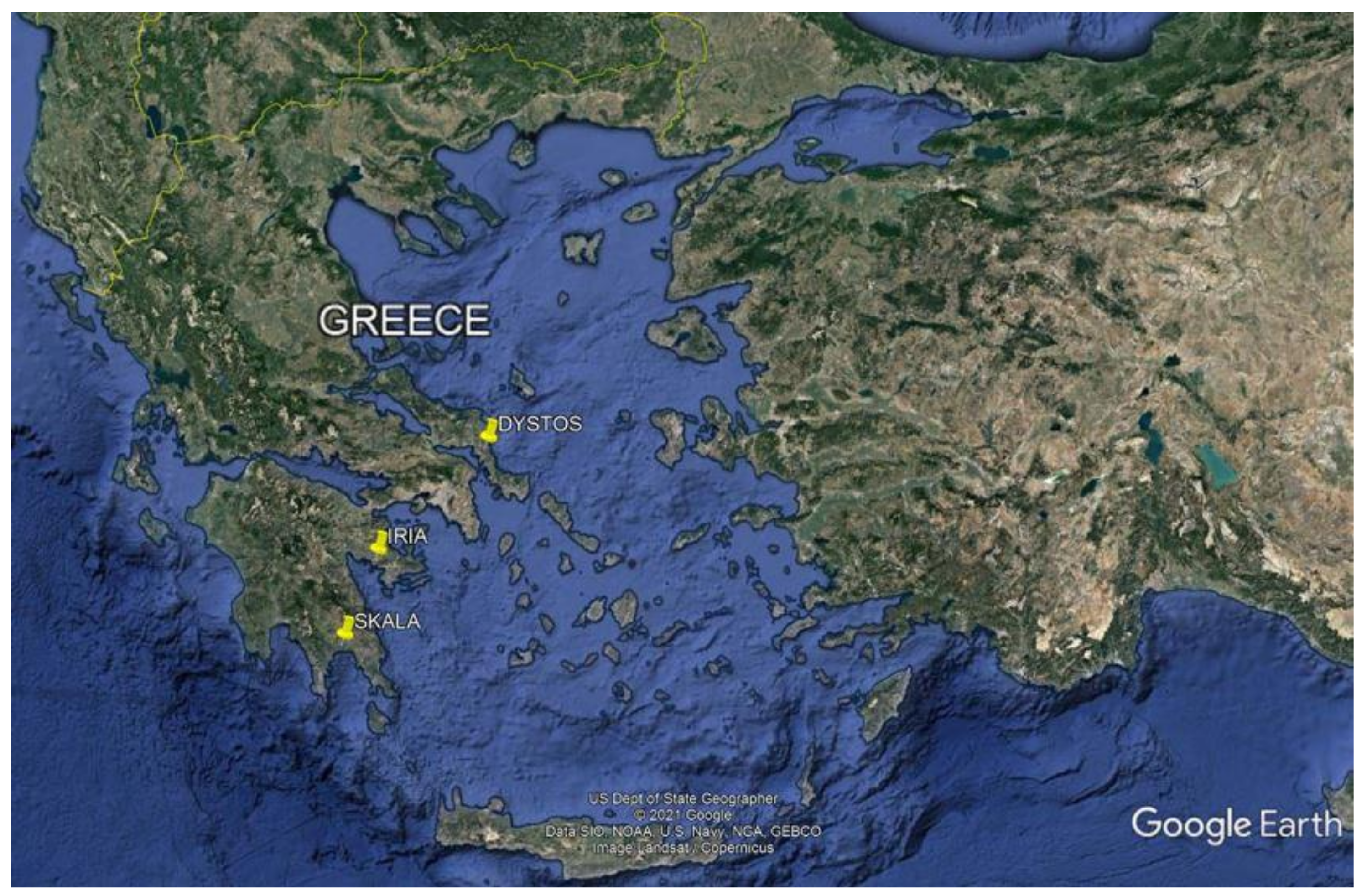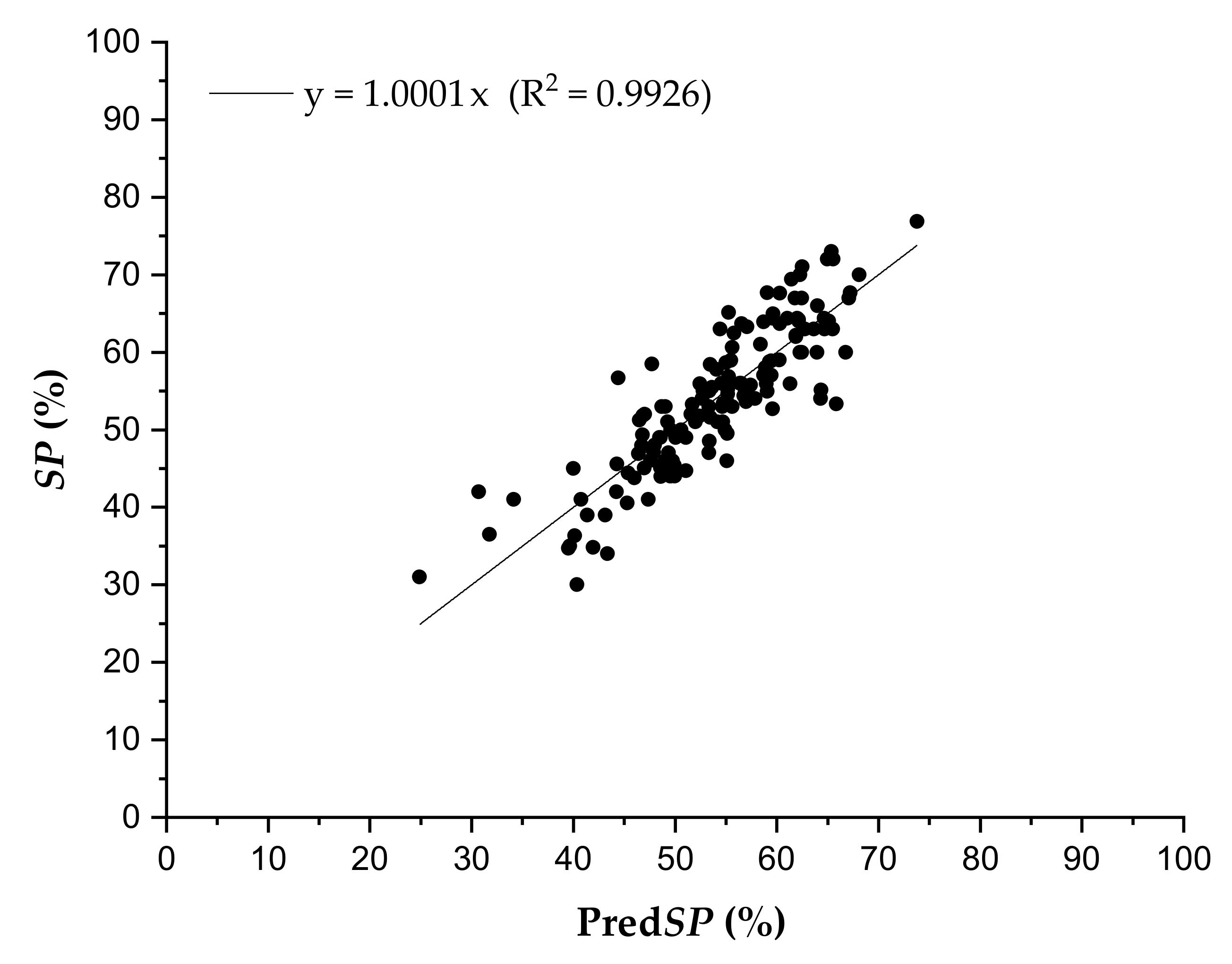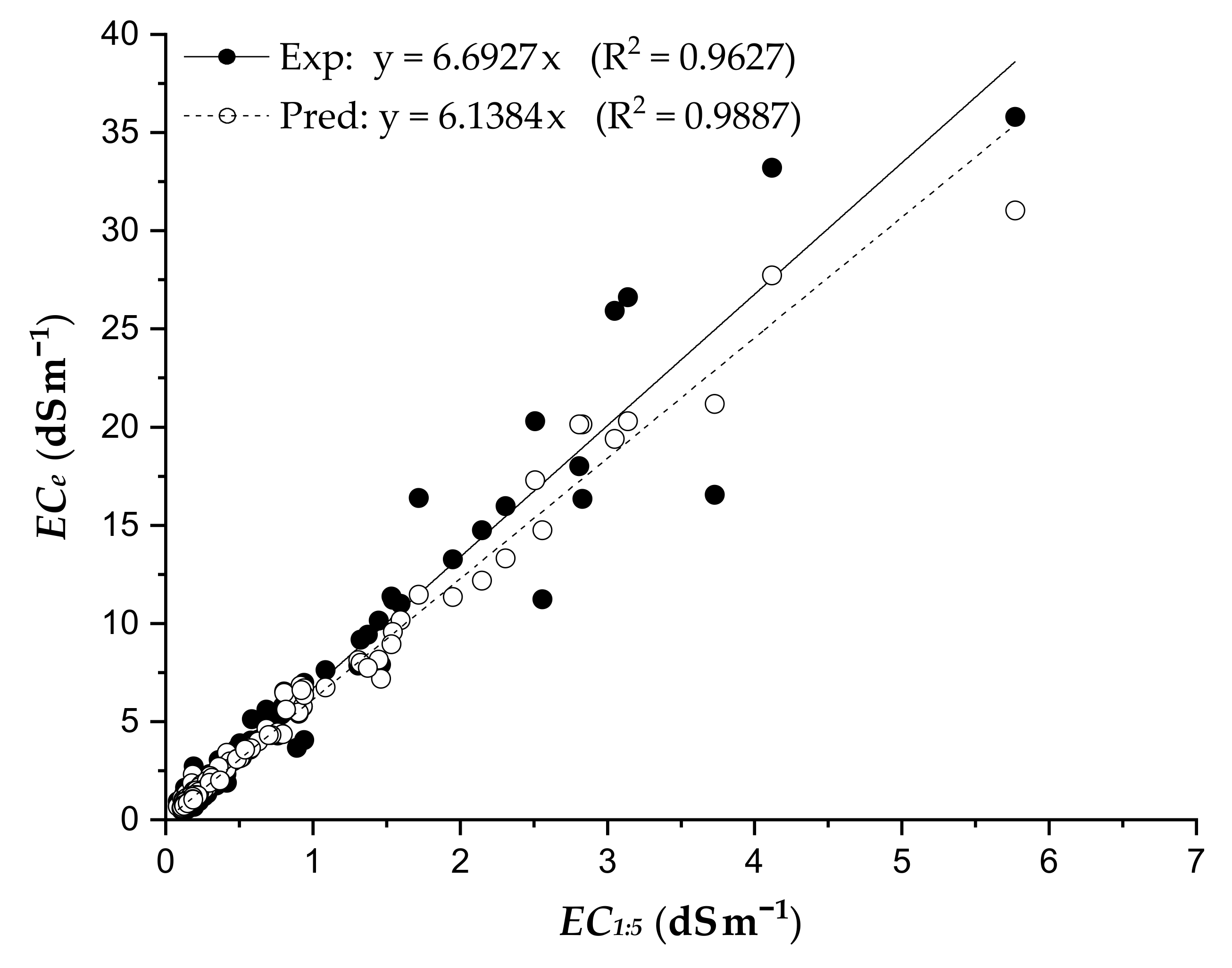The Effect of Soil Texture on the Conversion Factor of 1:5 Soil/Water Extract Electrical Conductivity (EC1:5) to Soil Saturated Paste Extract Electrical Conductivity (ECe)
Abstract
:1. Introduction
2. Materials and Methods
2.1. Case Studies
2.2. Determination of Electrical Conductivity
2.3. Statistical Analysis
3. Results and Discussion
3.1. Soil Properties
3.2. Relationship between ECe and EC1:5
3.3. Spearman Correlation Coefficients and Multiple Linear Regression
3.4. Prediction of ECe from EC1:5 and Soil Texture
4. Conclusions
Author Contributions
Funding
Institutional Review Board Statement
Informed Consent Statement
Conflicts of Interest
References
- FAO and ITPS. Status of the World’s Soil Resources (SWSR)-Main Report; Food and Agriculture Organization of the United Nations and Intergovernmetal Technical Panel on Soils: Rome, Italy, 2015; Available online: http:/www.Fao.org/3/a-i5199e.pdf (accessed on 12 May 2021).
- United States Department of Agriculture (USDA). Diagnoses and Improvement of Saline and Alkali Soils; Agriculture Handbook No. 60; United States Department of Agriculture: Washington, DC, USA, 1954. [Google Scholar]
- Corwin, D.L.; Lesch, S.M. Application of soil electrical conductivity to precision agriculture: Theory, principles and guidelines. Agron. J. 2003, 95, 455–471. [Google Scholar] [CrossRef]
- Rayment, G.E.; Lyons, D.J. Soil Chemical Analysis Methods-Australia; CSIRO Publishing: Collingwood, VIC, Australia, 2011. [Google Scholar]
- Wang, Y.; Wang, Z.X.; Lian, X.J.; Xiao, H.; Wang, L.Y.; He, H.D. Measurements of soil electrical conductivity in Tianjin coastal area. Tianjin Agric. Sci. 2011, 17, 18–21. [Google Scholar]
- He, Y.; DeSutter, T.; Prunty, L.; Hopkins, D.; Jia, X.; Wysocki, D. Evaluation of 1:5 soil to water extract electrical conductivity methods. Geoderma 2012, 185–186, 12–17. [Google Scholar] [CrossRef]
- Sonmez, J.S.; Buyuktas, D.; Okturen, F.; Citak, S. Assessment of different soil to water ratios (1:1, 1:2:5, 1:5) in soil salinity studies. Geoderma 2008, 144, 361–369. [Google Scholar] [CrossRef]
- Chi, M.C.; Wang, Z.C. Characterizing salt affected soils of Songnen Plain using saturated paste and 1:5 soil to water extraction methods. Arid Land Res. Manag. 2010, 24, 1–11. [Google Scholar] [CrossRef]
- Khorsandi, F.; Yazdi, F.A. Estimation of saturated paste extracts’ electrical conductivity from 1:5 soil/water suspension and gypsum. Commun. Soil Sci. Plant Anal. 2011, 42, 315–321. [Google Scholar] [CrossRef]
- Aboukila, E.F.; Abdelaty, E.F. Assessment of Saturated Soil Paste Salinity from 1:2.5 and 1:5 Soil-Water Extracts for Coarse Textured Soils. Alex. Sci. Exch. J. 2018, 38, 722–732. [Google Scholar] [CrossRef]
- Aboukila, E.F.; Norton, J.B. Estimation of saturated soil paste salinity from soil-water extracts. Soil Sci. 2017, 182, 107–113. [Google Scholar] [CrossRef]
- Kargas, G.; Chatzigiakoumis, I.; Kollias, A.; Spiliotis, D.; Massas, I.; Kerkides, P. Soil salinity assessment using saturated paste and mass soil:water 1:1 and 1:5 ratios extracts. Water 2018, 10, 1589. [Google Scholar] [CrossRef] [Green Version]
- Kargas, G.; Londra, P.; Sgoubopoulou, A. Comparison of Soil EC Values from Methods Based on 1:1 and 1:5 Soil to Water Ratios and ECe from Saturated Paste Extract Based Method. Water 2020, 12, 1010. [Google Scholar] [CrossRef] [Green Version]
- Slavich, P.G.; Petterson, G.H. Estimating the electrical conductivity of saturated paste extracts from 1:5 soil, water suspensions and texture. Aust. J. Soil Res. 1993, 31, 73–81. [Google Scholar] [CrossRef]
- Gharaibeh, M.A.; Albalasmeh, A.A.; Hanandeh, A.E. Estimation of saturated paste electrical conductivity using three modelling approaches: Traditional dilution extracts; saturation percentage and artificial neural networks. Catena 2021, 200, 105141. [Google Scholar] [CrossRef]
- Νorthcote, K.H. A Factual Key for the Recognition of Australian Soils. CSIRO; Rellim Technical Publications: Adelaide, Australia, 1979. [Google Scholar]
- Bouyoucos, G.H. A recalibration of the hydrometer method for making mechanical analysis of soils. Agron. J. 1951, 43, 434–438. [Google Scholar] [CrossRef] [Green Version]
- Nelson, R.E. Carbonate and gypsum. In Methods of Soil Analysis, Part 2: Chemical and Microbiological Properties, 2nd ed.; Page A., L., Ed.; ASA: Madison, WI, USA, 1982; pp. 181–197. [Google Scholar]





| Statistical Parameters | ECe | EC1:5 | SP | Clay | Sand |
|---|---|---|---|---|---|
| (dS m−1) | (dS m−1) | (%) | (%) | (%) | |
| Average | 4.01 | 0.61 | 53.98 | 31.53 | 36.12 |
| Standard deviation | 6.01 | 0.86 | 9.39 | 8.79 | 12.65 |
| Coefficient of variation (%) | 150.03 | 141.85 | 17.41 | 27.87 | 35.03 |
| Standard error | 0.49 | 0.07 | 0.77 | 0.72 | 1.04 |
| Minimum value | 0.47 | 0.08 | 30.0 | 7.40 | 3.56 |
| Maximum value | 35.80 | 5.77 | 76.84 | 48.50 | 84.60 |
| Coefficient of skewness | 3.01 | 3.05 | −0.14 | −0.11 | 0.63 |
| Coefficient of kurtosis | 10.34 | 11.19 | −0.27 | −0.36 | 1.16 |
| Soil Type | Number of Soil Samples | Mean Actual CF (ECe/EC1:5) | Mean Predicted CF | Mean Relative Error (%) |
|---|---|---|---|---|
| Clay | 24 | 4.72 | 5.45 | 15.0 |
| Clay Loam | 66 | 6.04 | 6.14 | 1.6 |
| Loam | 20 | 6.64 | 6.96 | 4.7 |
| Sandy Clay Loam | 14 | 6.66 | 7.07 | 6.2 |
| Sandy Loam | 9 | 8.22 | 8.17 | 0.5 |
| ECe | EC1:5 | SP | Clay | |
|---|---|---|---|---|
| EC1:5 | 0.942 *** | |||
| SP | −0.011 | 0.150 | ||
| Clay | −0.271 ** | −0.115 | 0.787 *** | |
| Sand | −0.054 | −0.204 * | −0.782 *** | −0.627 *** |
Publisher’s Note: MDPI stays neutral with regard to jurisdictional claims in published maps and institutional affiliations. |
© 2022 by the authors. Licensee MDPI, Basel, Switzerland. This article is an open access article distributed under the terms and conditions of the Creative Commons Attribution (CC BY) license (https://creativecommons.org/licenses/by/4.0/).
Share and Cite
Kargas, G.; Londra, P.; Sotirakoglou, K. The Effect of Soil Texture on the Conversion Factor of 1:5 Soil/Water Extract Electrical Conductivity (EC1:5) to Soil Saturated Paste Extract Electrical Conductivity (ECe). Water 2022, 14, 642. https://doi.org/10.3390/w14040642
Kargas G, Londra P, Sotirakoglou K. The Effect of Soil Texture on the Conversion Factor of 1:5 Soil/Water Extract Electrical Conductivity (EC1:5) to Soil Saturated Paste Extract Electrical Conductivity (ECe). Water. 2022; 14(4):642. https://doi.org/10.3390/w14040642
Chicago/Turabian StyleKargas, George, Paraskevi Londra, and Kyriaki Sotirakoglou. 2022. "The Effect of Soil Texture on the Conversion Factor of 1:5 Soil/Water Extract Electrical Conductivity (EC1:5) to Soil Saturated Paste Extract Electrical Conductivity (ECe)" Water 14, no. 4: 642. https://doi.org/10.3390/w14040642
APA StyleKargas, G., Londra, P., & Sotirakoglou, K. (2022). The Effect of Soil Texture on the Conversion Factor of 1:5 Soil/Water Extract Electrical Conductivity (EC1:5) to Soil Saturated Paste Extract Electrical Conductivity (ECe). Water, 14(4), 642. https://doi.org/10.3390/w14040642








